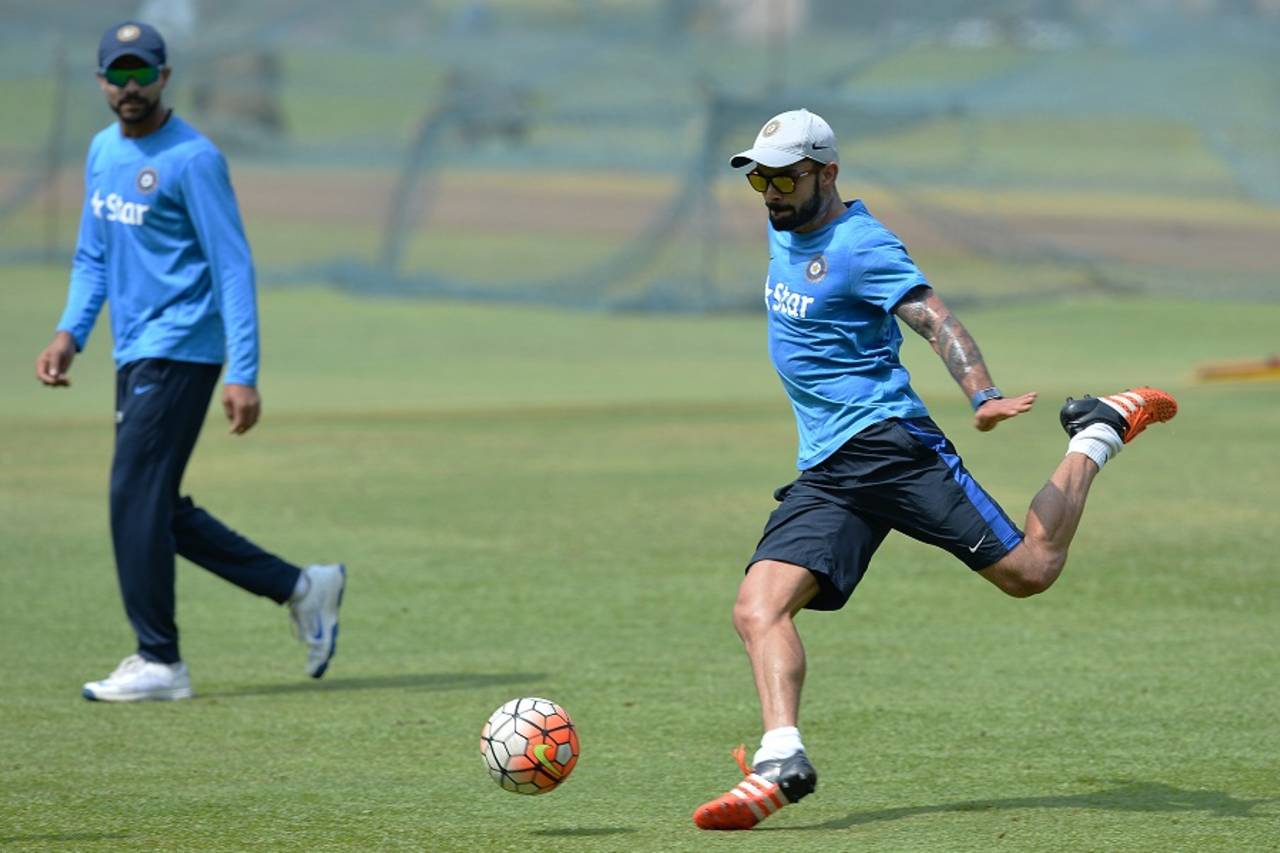The jack of all sports
How is it that the kids who are the best at one sport are invariably also good at others?
Sankaran Krishna
19-Aug-2016

How good was Virat Kohli at football as a kid? • AFP
A schoolboy's life in middle-class India in the late 1960s and early 1970s moved seamlessly from one sport to another with no evident guiding hand instructing us on when the switch was to be made. You played cricket for a few months, and then suddenly the field hockey sticks would come out, then it was time to kick a football around, and soon your attention turned to table tennis or badminton - more commonly the shuttlecock variety; less frequently the one played with a little woolly ball.
Such sports were interspersed with games of a more provincial provenance such as kabaddi, gilli-danda, seven-stones, and other assorted country cousins. Looking back, I have no idea how we knew to move from one to the other: the sequence went without saying, as it came without saying.
You might think the sheer abundance of sports would have made for an egalitarian playground in which those with limited talent in, say, cricket, could make up for it by excelling at soccer or field hockey or kabaddi. But you would be, for the most part, quite wrong. It was evident that the divine distribution of sporting talent or acumen was both unfair and capricious: the same guys who scored centuries in cricket were invariably the ones who banged in the goals in hockey or football, or walked away with the trophy at the end of the table tennis tournaments. These neighborhood dadas commanded the respect of everyone else and were much revered for their sporting acumen.
Conversely, those who made up the numbers in the cricket XI were also all too often the ones who spent their time futilely chasing the soccer ball but rarely coming into actual contact with it, let alone booting it into the goal. Part of the disenchantment of "growing up" was the realisation that there was no yet-to-be-discovered sport out there at which one might finally excel, exacting sweet revenge for all the daily humiliations endured until then.
One catches glimpses of the portable nature of exceptional sporting talent every now and then. I remember a Wimbledon crowd gasping in appreciation as Roger Federer casually and elegantly redirected a speeding tennis ball with pinpoint precision straight into the hands of a ball boy - with his foot. Clearly the Fed must have been a mean soccer player in his youth. And I once watched some grainy video footage of Yuvraj Singh playing tennis at an exhibition match that left no one in any doubt that the phenomenal eye-hand coordination that launched six sixes in an over translated into booming serves and topspin forehands as well. And the entire South African cricket team looks as if they could easily swap their whites for rugby or soccer jerseys and still hold their own.
I suspect the range of sports played by the average schoolboy has diminished considerably in the India of today, as cricket has risen to an unprecedented eminence and is pretty much played all year round
Looking back in my mind's eye at some of these talented but nameless allrounders from maidans in Bangalore and Chennai, a couple of things stand out. First, they had certain physical attributes that distinguished them from others. These included wiry or strong physiques much better developed than those of others in their own age group; keen eyesight; and an instinct for timing and positioning their bodies in such a way as to create optimal impact. They were, quite simply, physically more advanced than others in their peer group.
But it was a second, more ineffable, quality that set them apart, one that I did not, indeed could not, appreciate back then: it's almost as if they were able to watch the game from up on high, from a different vantage, which allowed them to see a certain grammar or geometry that was invisible to the rest of us. This translated into them having more time, appearing to be less rushed, than others. When they were batting, they instinctively knew where the fielders - that is to say the gaps in the field - were. When fielding they knew to read the angles faster and move towards the ball to cut it off rather than give chase after it was hit. And when bowling, they weren't the ones with the long run-ups and the grunting effort but the ones who got most of the wickets. Not surprisingly, these allrounders were invariably selected to be the captains of teams, irrespective of the sport, on which they played.
I suspect the range of sports played by the average schoolboy has diminished considerably in the India of today, as cricket has risen to an unprecedented eminence and is pretty much played all year round. Specialisation and organised playing of sport (rather than just playing with friends in the neighborhood) also happens earlier in life than it did in those relatively carefree days of the past.
While I remain quite skeptical that these developments will result in India's future cricketers being more competitive internationally, there is no doubt in my mind that the decline of the dada of the maidan, that effortless jack of all sports, is something to be mourned. They were the true allrounders of their times.
Sankaran Krishna is a professor of political science at the University of Hawaii, in Honolulu. @SankaranKrishn